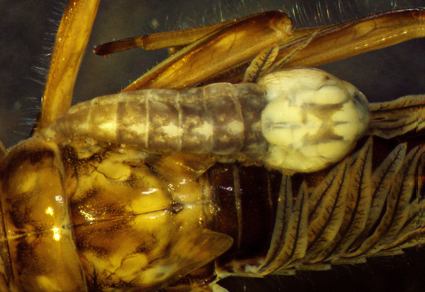Abstract
Chironomidae of symbiotic habits have been recorded in different parts of the world, among commensals and parasites. There are different genera reported at the moment, however questions such as the origin of commensal or parasitic life, which occurred first or what are their benefits remain debatable. In order to contribute with information to elucidate the above mentioned issues, the present study reports the finding of immature stages of Symbiocladius (Acletus) wygodzinskyi Roback, 1965 in the Churup stream located in the Andes Cordillera (Peru), living on nymphs of Leptophlebiidae (Ephemeroptera). We present a morphological description of immature stages of this species and for the first time the sequence of COX1 gene S. (A.) wygodzinskyi. The genetic result also supports differences between the morphospecies of Symbiocladius (Symbiocladius) rhithrogenae Zavřel, 1924 and S. (A.) wygodzinskyi in 23%.
References
- Caldwell, B.A. (1984) Two new species and records of other chironomids from Georgia (Diptera: Chironomidae) with some observations on ecology. Georgia Journal of Science, 42, 81–96.
- Claassen, P.W. (1922) The larva of a chironomid (Trissocladius equitans n.sp.) which is parasitic upon a may-fly nymph (Rhithrogena sp.). Kansas University Science Bulletin, 14, 395–399.
- Clark, K., Karsch-Mizrachi, I., Lipman, D.J., Ostell, J. & Sayers, E.W. (2016) GenBank. Nucleic acids research, 44 (D1), D67–D72. https://doi.org/10.1093/nar/gkv1276
- Codreanu, R. (1939) Recherches biologiques sur un chironomidae Symbiocladius rhithrogena (Zaver.)—ectoparasite “cancerigene” des Ephemeres torrenticoles. Archives de Zoologie Expirimentale et Generate, 81, 1–283.
- Dorvillé, L.F., Nessimian, J.L. & Sanseverino, A.M. (2000) First record of symphoresy between nymphs of the stonefly Kempnyia tijucana, and chironomid larvae, Nanocladius (Plecopteracoluthus) sp., in the Neotropics. Studies on Neotropical Fauna Environment, 35 (2), 109–114. https://doi.org/10.1076/0165-0521(200008)35:2;1-9;FT109
- Epler, J.H. (2001) Identification manual for the larval Chironomidae (Diptera) of North and South Carolina. FEBS Letters, 81 (2), 1.1–10.1.
- Ekrem, T., Willassen, E. & Stur, E. (2007) A comprehensive DNA sequence library is essential for identification with DNA barcodes. Molecular Phylogenetics Evolution, 43 (2), 530–542. https://doi.org/10.1016/j.ympev.2006.11.021
- Folmer, O., Black, M., Hoeh, W., Lutz, R. & Vrijenhoek, R. (1994) DNA primers for amplification of mitochondrial cytochrome c oxidase subunit I from diverse metazoan invertebrates. Molecular Marine Biology and Biotechnology, 3 (5), 294–299.
- Gonser, T. & Spies, M. (1997) Southern Hemisphere Symbiocladius (Diptera, Chironomidae) and their mayfly hosts (Ephemeroptera, Leptophlebiidae). In: Landolt, P. & Sartori, M. (Eds.), Ephemeroptera & Plecoptera: Biology—Ecology—Systematics. MTL., Fribourg: 455–466.
- Hayashi, F. (1998) Nanocladius (Plecopteracoluthus) asiaticus sp. n. (Diptera: Chironomidae) phoretic on dobsonfly and fishfly larvae (Megaloptera: Corydalidae). Aquatic Insects, 20 (4), 215‒229. https://doi.org/10.1076/aqin.20.4.215.4465
- Henriques-Oliveira, A.L. & Nessimian, J.L. (2009) Phoresy and commensalism of Chironomidae larvae (Insecta: Diptera) in the state of Rio de Janeiro, Brazil. Lundiana: International Journal of Biodiversity, 10 (1), 11–18. https://doi.org/10.35699/2675-5327.2009.23823
- Hynes, H.B.N. (1976) Symbiocladius aurifodinae sp. nov. (Diptera, Chironomidae), a parasite of nymphs of Australian Leptophlebiidae (Ephemeroptera). Memoirs of the National Museum, Victoria, 37, 47–52. https://doi.org/10.24199/j.mmv.1976.37.05
- Inoue, Y., Komori, C., Kobayashi, T., Kondo, N., Ueno, R. & Takamura, K. (2015) Nanocladius (Plecopteracoluthus) shigaensis sp. nov. (Chironomidae: Orthocladiinae) whose larvae are phoretic on nymphs of stoneflies (Plecoptera) from Japan. Zootaxa, 3931 (4), 551–567. https://doi.org/10.11646/zootaxa.3931.4.5
- Jacobsen, R.E. (1995) s.n. In: Corkum, L.D. & Ciborowski, J.J.H. (Eds.), Symbiotic associations between Chironomidae (Diptera) and Ephemeroptera. Canadian Scholars’ Press, Inc., Toronto, pp. 320–328.
- Kieffer, J. (1925) Deux genres nouveaux et plusieurs espèces nouvelles du groupe des Orthocladiariae (Dipteres, Chironomides). Annales de la Société scientifique de Bruxelles, 44, 555–566.
- Kimura, M. (1980) A simple method for estimating evolutionary rates of base substitutions through comparative studies of nucleotide sequences. Journal of Molecular Evolution, 16 (2), 111–120. https://doi.org/10.1007/BF01731581
- Krosch, M. & Cranston, P. (2012) Non-destructive DNA extraction from Chironomidae, including of fragile pupal exuviae, extends analysable collections and enhances vouchering. CHIRONOMUS Journal of Chironomidae Research, 25, 22–27. https://doi.org/10.5324/cjcr.v0i25.1532
- Lin, X., Stur, E. & Ekrem, T. (2015) Exploring genetic divergence in a species-rich insect genus using 2790 DNA barcodes. PLoS ONE, 10 (9), e0138993. https://doi.org/10.1371/journal.pone.0138993
- Makarchenko, E.A., Makarchenko, M.A. & Tiunova, T.M. (2015) A new species of Symbiocladius Kieffer, 1925 (Diptera: Chironomidae: Orthocladiinae) from the eastern palaearctic. European Journal of Environmental Sciences, 5 (1). [unknown pagination]
- Malloch, J.R. (1915) The Chironomidae or midges of Illinois, with particular reference to the species occurring in the Illinois River. Bulletin of the Illinois State Laboratory of Natural History, 10, 275–543. https://doi.org/10.21900/j.inhs.v10.376
- Pepinelli, M., Siqueira, T., Salles, F.F. & Shimbori, E.M. (2009) First report of Simuliidae and Chironomidae (Diptera) living on nymphs of Lachlania Hagen (Ephemeroptera: Oligoneuriidae) in South America. Biota Neotropica, 9, 245–247. https://doi.org/10.1590/S1676-06032009000100023
- Prat, N., Acosta, R. & Rieradevall, M. (2013) Presence of Symbiocladius wygodzinskyi Roback, 1965 (Diptera, Chironomidae) in Peru. Taxonomic remarks. Graellsia, 69 (1), 117–121. https://doi.org/10.3989/graellsia.2013.v69.074
- Ratnasingham, S. & Hebert, P.D.N. (2007) BOLD: The Barcode of Life Data System (http://www.barcodinglife.org). Molecular ecology notes, 7 (3), 355–364. https://doi.org/10.1111/j.1471-8286.2007.01678.x
- Roback, S.S. (1965) A new subgenus and species of Symbiocladius from South America (Diptera: Tendipedidae). Entomological News, 76 (5), 113–122.
- Sæther, O.A. (1977) Taxonomic studies on Chironomidae: Nanocladius, Pseudochironomus, and the Harnischia complex. Bulletin of the Fisheries Research Board of Canadá, 196, 1–143.
- Steffan, A.W. (1968) Zur Evolution und Bedeutung epizoischer Lebensweise bei Chironomiden—Larven (Diptera). Annales Zoologici Fennici, 5 (1), 144–150. [http://www.jstor.org/stable/23731458]
- Svensson, B.S. (1979) Pupation, emergence and fecundity of phoretic Epoicocladius ephemerae (Chironomidae). Ecography, 2 (1), 41–50. https://doi.org/10.1111/j.1600-0587.1979.tb00680.x
- Tamura, K., Stecher, G. & Kumar, S. (2021) MEGA11: molecular evolutionary genetics analysis version 11. Molecular Biology and Evolution, 38 (7), 3022–3027. https://doi.org/10.1093/molbev/msab120
- Tokeshi, M. (1986) Population ecology of the commensal chironomid Epoicocladius flavens on its mayfly host Ephemera danica. Freshwater Biology, 16 (2), 235–243. https://doi.org/10.1111/j.1365-2427.1986.tb00967.x
- Tokeshi, M. (1993) On the evolution of commensalism in the Chironomidae. Freshwater Biology, 29 (3), 481–489. https://doi.org/10.1111/j.1365-2427.1993.tb00782.x
- Trifinopoulos, J., Nguyen, L.-T., von Haeseler, A. & Minh, B.Q. (2016) W-IQ-TREE: a fast online phylogenetic tool for maximum likelihood analysis. Nucleic acids research, 44 (W1), W232–W235. https://doi.org/10.1093/nar/gkw256


